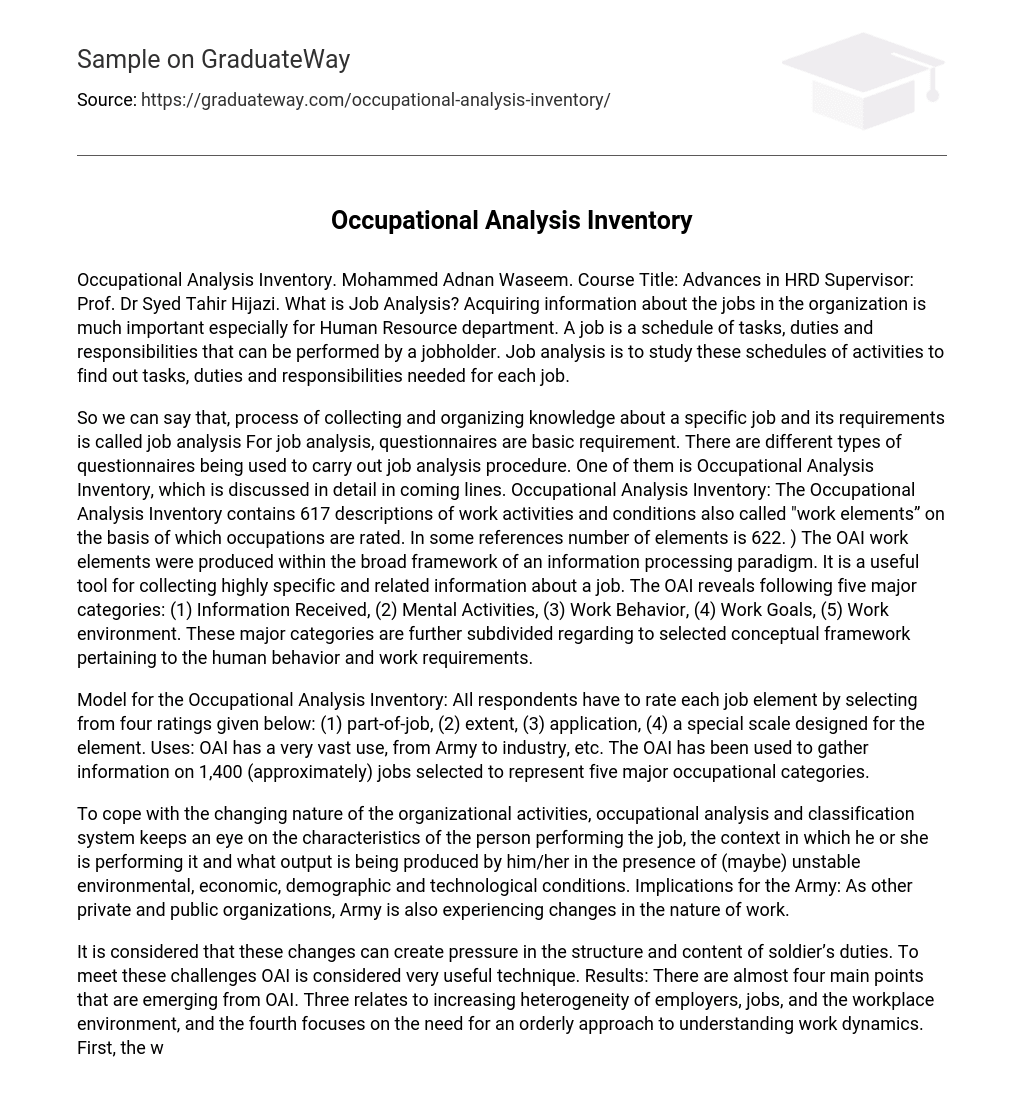Acquiring information about the jobs in the organization is much important especially for Human Resource department. A job is a schedule of tasks, duties and responsibilities that can be performed by a jobholder. Job analysis is to study these schedules of activities to find out tasks, duties and responsibilities needed for each job.
So we can say that, process of collecting and organizing knowledge about a specific job and its requirements is called job analysis For job analysis, questionnaires are basic requirement. There are different types of questionnaires being used to carry out job analysis procedure. One of them is Occupational Analysis Inventory, which is discussed in detail in coming lines. Occupational Analysis Inventory: The Occupational Analysis Inventory contains 617 descriptions of work activities and conditions also called “work elements” on the basis of which occupations are rated. In some references number of elements is 622.
The OAI work elements were produced within the broad framework of an information processing paradigm. It is a useful tool for collecting highly specific and related information about a job. The OAI reveals following five major categories:
- Information Received,
- Mental Activities,
- Work Behavior,
- Work Goals,
- Work environment.
These major categories are further subdivided regarding to selected conceptual framework pertaining to the human behavior and work requirements.
Model for the Occupational Analysis Inventory: AIl respondents have to rate each job element by selecting from four ratings given below:
- part-of-job,
- extent,
- application,
- a special scale designed for the element.
Uses: OAI has a very vast use, from Army to industry, etc. The OAI has been used to gather information on 1,400 (approximately) jobs selected to represent five major occupational categories.
To cope with the changing nature of the organizational activities, occupational analysis and classification system keeps an eye on the characteristics of the person performing the job, the context in which he or she is performing it and what output is being produced by him/her in the presence of (maybe) unstable environmental, economic, demographic and technological conditions. Implications for the Army: As other private and public organizations, Army is also experiencing changes in the nature of work. It is considered that these changes can create pressure in the structure and content of soldier’s duties. To meet these challenges OAI is considered very useful technique.
Results: There are almost four main points that are emerging from OAI. Three relates to increasing heterogeneity of employers, jobs, and the workplace environment, and the fourth focuses on the need for an orderly approach to understanding work dynamics. First, the workforce is becoming more diverse with respect to demographics; these dynamics appear to have resulted in greater heterogeneity within traditional occupational categories.
Second, the differentiation among jobs and departments is becoming another threatening issue. Third the work structure issue appears to be increasing, and these decisions are interdependent. The fourth and final theme emerges from this interdependency. Limitations: Results obtained by Occupational Analysis Inventory have been moderate not so much reliable. According to some analysts, their level is almost lower than other used methods (e. g. PAQ , WPS etc. ).
There are three reasons that why we use OAI:
- It is an appropriate way which guarantees highly competitive recruiting, hiring, classifying, training, promoting and out-placing your most valuable resource (your workforce);
- It’s an easy way to train and retain the best qualified people;
- It is a more flexible on the item inventories (tasks, competencies, knowledge-skill-abilities, etc. )
Comparison with other Methods: If we compare it with Fleishman Job Analysis Survey, F-JAS model is a system to describe jobs from the point of view of necessary capacities. While OAI was designed to yield more specific job information relating to all elements of job, not only necessary capacities.
If we compare it with Functional Job Analysis, FJAS requires specific additional skills or others that may not be as necessary as originally thought for conducting the survey. In this way it becomes specific task not a general purpose. While in OAI, there is no limitation of this type. If we compare it with MOSAIC, MOSAIC uses (almost) close ended questions, which limits its results. Because questionnaires at this level should be a mixture of both (open ended and close ended).
Another negative of MOSAIC is that, it takes 151 job elements rated in terms of importance for effective job performance, while OAI uses 617 job elements. If we compare it with Position Analysis Questionnaire, PAQ does not describe the tasks, technologies, or duties of jobs. It just measures job characteristics and relates them to human characteristics. While OAI describes the occupation in much details. If we compare it with Work Profiling System, WPS is only computer-administered on-site at a company. It just measures ability and personality attributes, while leaving others.





